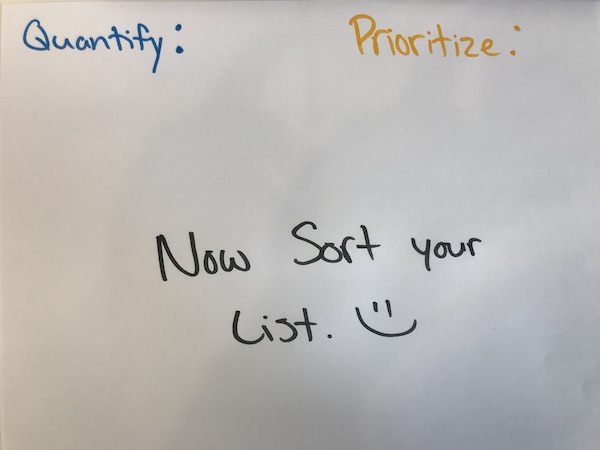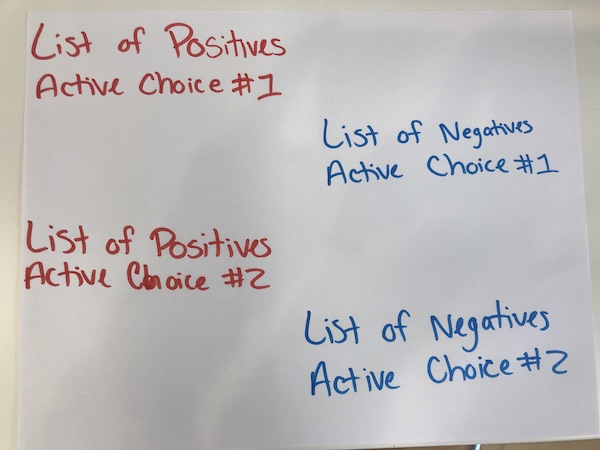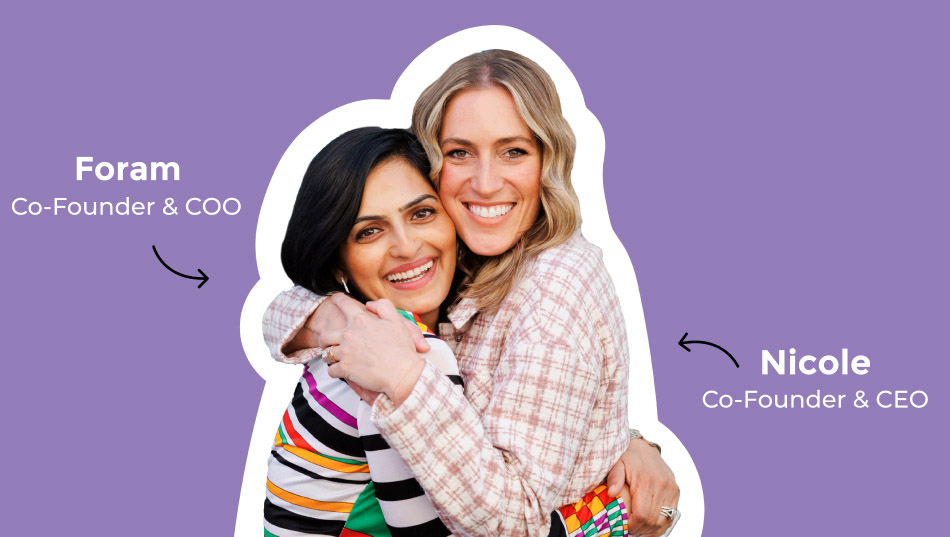How To Make Good Decisions

Have you ever heard of the “coin flip” trick for making decisions? It might not be what you’re thinking!
Here’s how it works: If you’re faced with a decision between two options, assign heads to one and tails to the other, then flip a coin. Catch it and cover it so you can’t see the outcome yet.
That’s the trick. When you’ve flipped but haven’t looked yet – which side are you hoping for?
When it comes right down to the wire, there will be one option you want to happen more than the other; deep in your heart, you’ll be rooting for either heads or tails in that split second before you see. You can drop the coin without ever looking – you’ve got your answer!
Not every decision can be handled this way, of course. For starters, some decisions are between more than two options! But the core concept – that we often over-complicate decisions that in reality are simple – remains true.
I’m going to talk about how to de-complicate ANY decision, not just the choice between two dinner options!
Removing the Obstacles
Most of the time, difficulty in making a decision isn’t a matter of not having the information or intelligence to do so. You’ve got that! It’s usually a matter of an additional, negative aspect impeding the process. If you need more information you can get it, but what do we do when we have all the right info, and it’s just time to pull the trigger?
Over the years I’ve identified three major obstacles that people tend to face when making really tough decisions about their lives, careers, families, or other important topics. I’m going to talk about each one, and the techniques I’ve used (and helped others to use!) to overcome them.
Obstacle Number One: You’re Way, Way Too Close To The Problem
Emotional investment and bias is a major obstacle to decision-making. When you’re feeling overwhelming negative emotions of any kind, you’re not going to be doing your best work. Don’t worry – my advice to isn’t going to be something silly like “don’t be sad.” That’s not helpful nor actionable advice! Instead, I’m going to help separate the parts of your mind that are feeling those stressors from the part of your mind that has to make this decision.
First, write down a list of 3-5 generic things about you. Anything will do! For instance, I might write: “Lives in New Jersey. Has three kids. Late 30’s. Incredibly handsome. Very funny.”
Then, write down another 3-5 things that are relevant to the tough decision. So, if the decision I was facing was whether to keep my house in the suburbs or move to the city, I might write: “Likes having a yard. Has a daughter that loves playing outside. Hates having a long commute. Has no pets. Has a wife that wants a cat.” (If you’ve tried to make a Pros & Cons list for your decision already, that can be a good source for these.)

Next, draw a stick figure. Yes, I’m serious. Just draw a little stick-figure person. Pick a random first name that isn’t your name, and write “This is [name],” next to that stick figure. So I would write: “This is Jim.”
Then write out all the traits from both your lists, but say “Jim is…” for each. “Jim is in his late 30’s and lives in NJ with his three kids. Jim’s incredibly handsome and very funny. Jim loves having a yard but hates commuting to work. Jim’s daughter loves the outdoors. Jim has no pets, but his wife really wants a cat.” Then write the decision Jim is facing: “Jim is trying to decide whether he should stay in the suburbs, or move to the city where he works. Jim wants your advice. What should Jim do?”
This method takes the same information but presents it to you in a way that removes a lot of the emotional component. It helps you visualize the problem from the outside, instead of being stuck in the middle. Chances are very good that when presented this way, the answer will seem far more obvious than when you were trying to make the decision for “you.”
Obstacle Number Two: Every Priority Is The Highest Priority
We all have things that are important to us. When we’re making a big decision, we’re trying to pursue those things. But it’s a simple truth that we can’t have everything – decisions are about change, and change involves compromise.
Our brains aren’t wired to take multiple competing concepts and evaluate them against one another fairly and honestly. Humans just aren’t good at that. If I ask you if good gas mileage is important to you in a car, you might be easily able to say “yes,” because the decision is whether you do or don’t like good gas mileage. That’s easy. If I ask you if safety is important to you in a car, you can easily say “yes” again for the same reason. But if ask which is more important, suddenly you’re stuck. That’s natural, but we have to overcome it in order to make a decision.
This next exercise is very challenging, but the rewards are tremendous.
Write down a list of everything that’s important to you in the realm of the decision you’re making. So if you’re looking at cars, you can write down “Price, mileage, safety, room,” and anything else you care about. Don’t use a single sheet of paper – put everything on a separate piece, or on index cards, or post-it notes, or anything that lets them freely move. Then here’s the challenging part: You’re going to QUANTIFY and PRIORITIZE.
Quantify:
You can’t just say “Price.” That won’t get you anywhere. You have to put a number on it: The maximum price you’re willing to pay. For gas mileage, you have to put down a number that’s your goal. For safety, put down the rating you’re looking for. Be specific!
Prioritize:
Now, put your index cards or whatever you’ve used in the order of importance. There can only be one card on the top of the stack! To do this, use the following sentence: “There is nothing that would make me compromise on _________, so it’s #1.” That’s your top card. Then, say “The only thing that would make me compromise on ________ is #1, so it’s #2.” Then, “The only things that would make me compromise on __________ are #1 and #2, so it’s #3.”

Let me illustrate with the car example. Let’s say that safety is the most important thing to me – I have small kids so I’m willing to give up anything else for their safety as a priority. So that’s #1! Then I say, “Okay, I want to pay as little as possible, but only if I don’t sacrifice safety.” Price becomes #2 then. Then I say, “It needs to have enough room for 3 kids, 2 adults, plus storage space for things like strollers or groceries.” Now visualize: If there were two cars, and one cost less but could only fit 2 kids and had a small trunk, while the other had all the room but cost more, which would I pick? Since I’d pick the roomier one, I now realize room should actually be #2, and Price gets bumped down to #3.
This method of comparing only two things at a time and creating a solid priority list as a result is what creates a framework to evaluate your options. If I do this step and create my solid list, then when I go to the car dealership it’ll be really easy for me to pick! I’ll start with only cars with a 5-star safety rating, sine that’s priority #1. Then, of those, I’ll eliminate all the ones that aren’t big enough, since that’s #2. And so on down the list until the decision is easy.
The important thing is to step back and create that list independently of the specific choices themselves. I wasn’t naming specific cars when I created the list, I was naming features that I care about. You should always have your priorities well-defined because you will have to compromise on something at some point. This will force you to take a step back and look at what’s really important, and ask yourself if you’ve been acting in accordance with that. For instance, maybe when you make this list about what you want in a job, your clear thoughts lead you to Priority #1 being a healthy, non-toxic work environment. But when you’re actually on the job hunt, you’ve been pursuing roles based on salary, even though many of them are in stressful industries. That could be just the wake-up call you need to realize you’ve been working against yourself.
Obstacle Number Three: The Fear of Failure
Are there any words more terrifying than “what if?” When we’re faced with any decision, we fear the unknown more than we fear almost anything else. We’re afraid of “wrong decisions” far more than we’re excited about right ones!
The first step to overcoming the fear of failure is to recognize that it’s totally unavoidable. You’re definitely going to fail! Maybe not this time, but eventually. One or more of the decisions you make in your life will turn out to be disasters. There is simply no getting around this. Fearing something that’s definitely going to happen won’t help you avoid it. But of course, if it were rational, it wouldn’t be fear – so how do we actually come to terms with that?
We tend to feel the most fear not when we’re presented with a choice between two active options.
When faced with a choice between action and inaction. For instance, the decision between which of two job offers to accept might cause a little anxiety. Generally, that can be solved with the prior methods. On the other hand, trying to decide between quitting your job to look for a new career and not doing that tends to produce a lot of fear. Two new job offers both represent the unknown, so even if you’re afraid, you’re probably equally afraid of both and it’s a wash. Even if your current job makes you miserable, you probably aren’t afraid of it. And fear is often more powerful than misery!

Time to make lists again! (Can you tell that visualization is a powerful force?) On one piece of paper, write down all the aspects of the “active” choice, whether they’re pros or cons. Write down positive things like better compensation and increased satisfaction, but also potential negatives like harder work or the stress of a job hunt. Then, take out a different piece of paper (this is important!) Write down everything about your current job, good and bad.
Then, put both pieces of paper on the table next to each other. Imagine you’re unemployed, and both pieces of paper represent job offers. Which would you take?
Now you’ve turned the decision into one between two active choices, instead of between one active choice and continuing to do nothing. You might see how easy it is to quit once you look at it that way – or you may see how silly it was to even consider quitting, considering all the good things about your current job compared to the relatively minor bad ones. Either way, the visualization between two active choices helps clear away the fear!
Putting It All Together
Stepping back from a decision, clearly defining your priorities, and overcoming the fear of the unknown are all essential components of making good decisions. One (or more!) of those obstacles might be slowing you down, and hopefully I’ve shown you some actionable ways to get over them. Whether these methods work for you or not, the core principles are the same. Step back, prioritize, and recognize that the worst case scenario is nothing to be afraid of. Best of luck in all your decisions!








